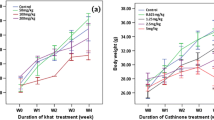Abstract
In the present study, ten different sea weeds from Visakhapatnam sea coast, India, were selected for the identification of potential immunomodulatory property using Balb/(c) mice. The aqueous extract of Sargassum vulgare, Padina tetrastromatica, and Amphiroa fragilissima exhibited alleviated levels against ovalbumin-specific IgG and IgM antibody responses using Balb/(c) mice for immunomodulator properties. The IgG and IgM levels were determined by enzyme-linked immunosorbent assay (ELISA). The seaweed aqueous extracts have been further subjected to activity-guided organic solvent (chloroform, ethyl acetate, and ethanol) fractionation. The ethanolic fraction of these sea weeds has shown the highest activity. The results obtained in this study shown that ethanolic extracts of Padina tetrastromatica enhanced levels of IgG and IgM when compared to other solvent extracts. Immunomodulation results in fine tuning the responses of different components of immune system. The putative immunomodulatory principles present in the ethanolic fractions of these seaweeds can be therapeutically useful as a remedy to treat autoimmune diseases, hypersensitivity, etc.




Similar content being viewed by others
References
Mancini I, Defant A, Guella G. Recent synthesis of marine natural products with antibacterial activities. Anti-Infective Agents in Medicinal Chemistry. 2007;6:17–48. (1 st ref)
Holdt SL, Kraan S. Bioactive compounds in seaweed: functional food applications and legislation. J Appl Phycol. 2011;23:543–97. doi:10.1007/s10811-010-9632-5.
Chandini SK, Ganesan P, Suresh PV, Bhaskar N. Seaweeds as a source of nutritionally beneficial compounds—a review. J Food Sci Technol. 2008;45(1):1–13.
Pal A, Kamthania MC, Kumar A. Bioactive compounds and properties of seaweeds—a review. Open Access Library Journal. 2014;1:e752. doi:10.4236/oalib.1100752.
Gerwick WH, Moore BS. Lessons from the past and charting the future of marine natural products drug discovery and chemical biology. Chemistry & Biology. 2012;19(1):85–98. doi:10.1016/j.chembiol.2011.12.014.
Dawczynski C, Schubert R, Jahreis G. Amino acids, fatty acids, and dietary fibre in edible seaweed products. Food Chem. 2007;103:891–9. doi:10.1016/j.foodchem.2006.09.041.
Gerwick WH, Bernart MW. Eicosanoids and related compounds from marine algae. In: Attaway DH, Zaborsky OR, editors. Marine biotechnology, 1, pharmaceutical and bioactive natural products. New York: Plenum Press; 1993. p. 101–52.
Zhou GF, Sun YP, Xin X, Zhang YN, Li ZE, Xu ZH. In vivo antitumor and immunomodulation activities of different molecular weight lambda-Carrageenans from Chondrus ocellatus. Pharmacol Res. 2004;50:47–53. doi:10.1016/j.phrs.2003.12.002.
Murata M, Nakazoe J. Production and use of marine algae in Japan. Japan Agricultural Research Quarterly. 2001;35:281–90.
Lins KOAL, Bezerra DP, Alves APNN, Alencar NMN, Lima MW, Torres VM, Farias WRL, Pessoa C, de Moraes MO, Costa-Lotufo LV. Antitumor properties of a sulfated polysaccharide from the red seaweed Champia feldmannii (Diaz-Pifferer). J Appl Toxicol. 2008;29:20–6. doi:10.1002/jat.1374.
Patil US, Jaydeokar AV, Bandawane DD. Immunomodulators: a pharmacological review. Int J Pharm Pharm Sci. 2012;4(1):30–6.
Londhe V, Parikh R. Can levamisole alone maintain the immunity. Int Jrnl of pharmacy and pharmaceutical sciences. 2011;3(2):161–4.
Aparanji P, Rama RA. Immunosuppressive properties of aqueous extract of Plumbago zeylanica in Balb/c mice. Journal of Medicinal Plants Research. 2010;4(20):2138–43.
Sell S. Immunology immunopathology and immunity. New York: Elsevier Science Publishing Co. Inc; 1987 .Immunomodulation; pp. 655–83
Salgado J, Gilbert A, Franch A, Castell M, Castellote C, Queralt J. Effect of adjuvants on IgG and IgE response to ovalbumin in rats. Allergol Immunopathol (Madr). 1989;17(5):237–40.
Chandraraj S, Prakash B, Navanath K. Immunomodulatory activities of ethyl acetate extract of two marine sponges Gelliodes fibrosa and Tedania anhelans and brown algae Sargassum ilicifolium with reference to phagocytosis. Res J Pharm Biol Chem Sci. 2010;1:302–7.
Acknowledgements
The authors are grateful to the UGC, New Delhi, India (Grant No: 42-228/2013 (SR) Dt. 22nd March 2013) for the financial support and management of GITAM University, Visakhapatnam, India, for providing facilities to carry out this work.
Author information
Authors and Affiliations
Corresponding author
Rights and permissions
About this article
Cite this article
Talluri, V.P., Kandula, S.K. & Saladi, R.V. Identification of Seaweeds from North Visakhapatnam Sea Coast Exhibiting Immunomodulatory Activity Using Balb/c Models. Regen. Eng. Transl. Med. 3, 70–74 (2017). https://doi.org/10.1007/s40883-017-0024-0
Received:
Accepted:
Published:
Issue Date:
DOI: https://doi.org/10.1007/s40883-017-0024-0




